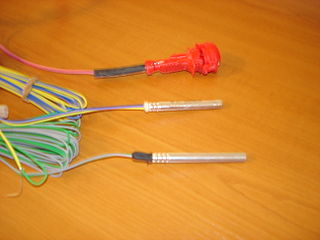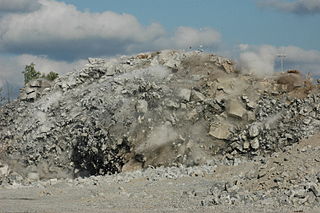
An explosive is a reactive substance that contains a great amount of potential energy that can produce an explosion if released suddenly, usually accompanied by the production of light, heat, sound, and pressure. An explosive charge is a measured quantity of explosive material, which may either be composed solely of one ingredient or be a mixture containing at least two substances.

Semtex is a general-purpose plastic explosive containing RDX and PETN. It is used in commercial blasting, demolition, and in certain military applications.

Cordite is a family of smokeless propellants developed and produced in Britain since 1889 to replace black powder as a military firearm propellant. Like modern gunpowder, cordite is classified as a low explosive because of its slow burning rates and consequently low brisance. These produce a subsonic deflagration wave rather than the supersonic detonation wave produced by brisants, or high explosives. The hot gases produced by burning gunpowder or cordite generate sufficient pressure to propel a bullet or shell to its target, but not so quickly as to routinely destroy the barrel of the gun.

A detonator, sometimes called a blasting cap in the US, is a small sensitive device used to provoke a larger, more powerful but relatively insensitive secondary explosive of an explosive device used in commercial mining, excavation, demolition, etc.

C-4 or Composition C-4 is a common variety of the plastic explosive family known as Composition C, which uses RDX as its explosive agent. C-4 is composed of explosives, plastic binder, plasticizer to make it malleable, and usually a marker or odorizing taggant chemical. C-4 has a texture similar to modelling clay and can be molded into any desired shape. C-4 is relatively insensitive and can be detonated only by the shock wave from a detonator or blasting cap.

Richard Colvin Reid, also known as the "Shoe Bomber", is the perpetrator of the failed shoe bombing attempt on a transatlantic flight in 2001. Born to a father who was a career criminal, Reid converted to Islam as a young man in prison after years as a petty criminal. Later he became radicalized and went to Pakistan and Afghanistan, where he trained and became a member of al-Qaeda.
Primacord is a brand of detonating cord used in blasting. The registered trademark Primacord was originally owned by the Ensign-Bickford Company; Ensign-Bickford sold the trademark to Dyno Nobel in 2003, who manufacture it in their Graham, Kentucky factory. The name is also used as a genericized trademark for any detonating cord.

Stielhandgranate is the German term for "stick hand grenade" and generally refers to a prominent series of World War I and World War II–era German stick grenade designs, distinguished by their long wooden handles, pull cord arming and cylindrical warheads. The first models were introduced by the Imperial German Army during World War I and the final design was introduced during World War II by the German Wehrmacht.

Detonating cord is a thin, flexible plastic tube usually filled with pentaerythritol tetranitrate. With the PETN exploding at a rate of approximately 6,400 m/s (21,000 ft/s), any common length of detonation cord appears to explode instantaneously. It is a high-speed fuse which explodes, rather than burns, and is suitable for detonating high explosives. The detonation velocity is sufficient to use it for synchronizing multiple charges to detonate almost simultaneously even if the charges are placed at different distances from the point of initiation. It is used to reliably and inexpensively chain together multiple explosive charges. Typical uses include mining, drilling, demolitions, and warfare.

Slow match, also called match cord, is the slow-burning cord or twine fuse used by early gunpowder musketeers, artillerymen, and soldiers to ignite matchlock muskets, cannons, shells, and petards. Slow matches were most suitable for use around black-powder weapons because a slow match could be roughly handled without going out, and only presented a small glowing tip instead of a large flame that risked igniting nearby gunpowder. Slow match of various types was one of the first kinds of artillery fuse.
Ballistite is a smokeless propellant made from two high explosives, nitrocellulose and nitroglycerine. It was developed and patented by Alfred Nobel in the late 19th century.

A tripwire is a passive triggering mechanism. Typically, a wire or cord is attached to a device for detecting or reacting to physical movement.

Drilling and blasting is the controlled use of explosives and other methods, such as gas pressure blasting pyrotechnics, to break rock for excavation. It is practiced most often in mining, quarrying and civil engineering such as dam, tunnel or road construction. The result of rock blasting is often known as a rock cut.

An aircraft canopy is the transparent enclosure over the cockpit of some types of aircraft. An aircraft canopy provides a controlled and sometimes pressurized environment for the aircraft's occupants, and allows for a greater field of view over a traditional flight deck. A canopy's shape is a compromise designed to minimize aerodynamic drag, while maximizing visibility for pilots and other crewmembers.
Baghdad Soldiers, working together with Iraqi Army troops, discovered two caches totaling approximately 700 lbs. of homemade explosives in the early morning hours of 15 July 2007 in Operation Purple Haze.
In military munitions, a fuze is the part of the device that initiates function. In some applications, such as torpedoes, a fuze may be identified by function as the exploder. The relative complexity of even the earliest fuze designs can be seen in cutaway diagrams.

A grenade is an explosive weapon typically thrown by hand, but can also refer to a shell shot from the muzzle of a rifle or a grenade launcher. A modern hand grenade generally consists of an explosive charge ("filler"), a detonator mechanism, an internal striker to trigger the detonator, an arming safety secured by a transport safety. The user removes the transport safety before throwing, and once the grenade leaves the hand the arming safety gets released, allowing the striker to trigger a primer that ignites a fuze, which burns down to the detonator and explodes the main charge.
A shock tube detonator is a non-electric explosive fuze or initiator in the form of small-diameter hollow plastic tubing used to transport an initiating signal to an explosive by means of a shock wave traveling the length of the tube. Shock tube is used to convey a detonation signal to a detonator. Shock tube is a hollow extruded tube containing a thin layer of energetic material upon its inner diameter. Once it is initiated, the shock tube transfers a signal to a detonating output charge.

Demolition is the science and engineering in safely and efficiently tearing down of buildings and other artificial structures. Demolition contrasts with deconstruction, which involves taking a building apart while carefully preserving valuable elements for reuse purposes.

The Shaving Stick Grenade was an offensive grenade that was developed by Germany and used by the Wehrmacht during World War II.














